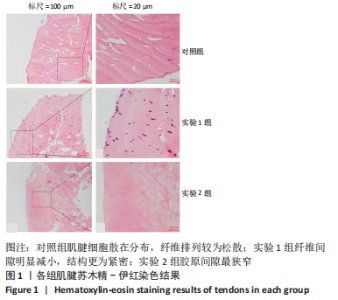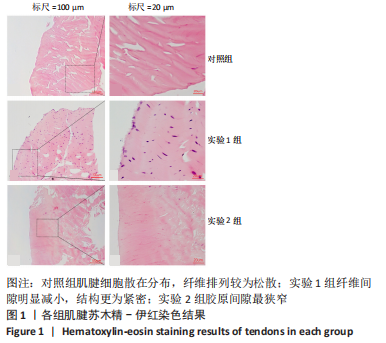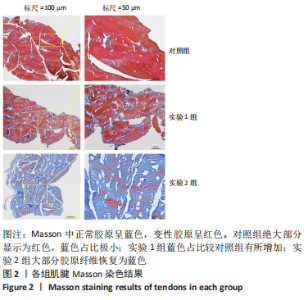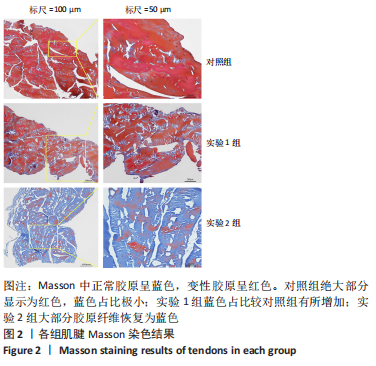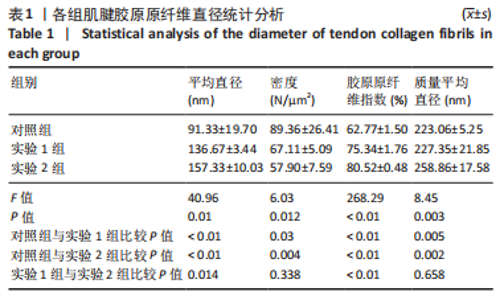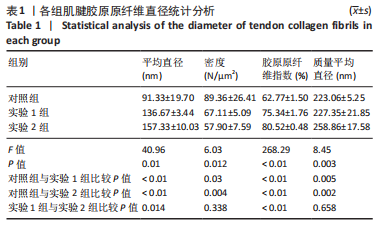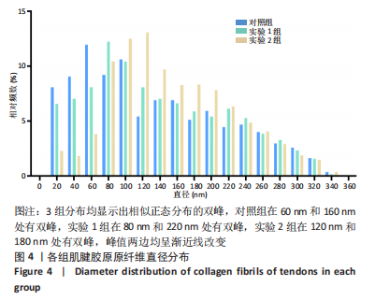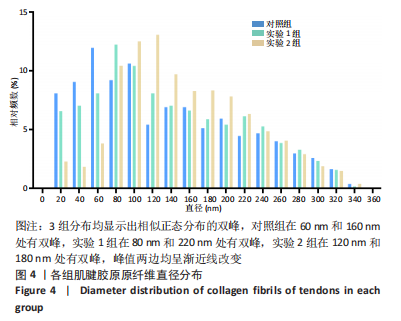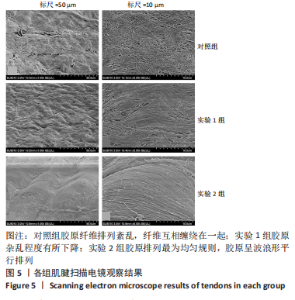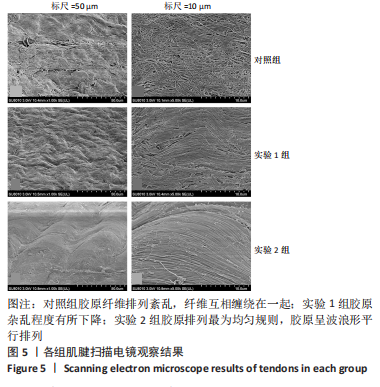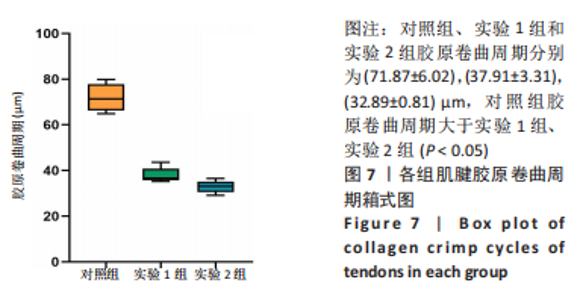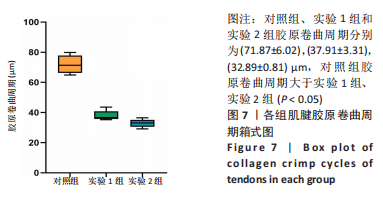Chinese Journal of Tissue Engineering Research ›› 2023, Vol. 27 ›› Issue (21): 3307-3313.doi: 10.12307/2023.455
Previous Articles Next Articles
Peracetic acid-ethanol treated tendons crosslinked with 1-ethyl-3-(3-dimethylaminopropyl)carbodiimide combined with N-hydroxysuccinimide: morphological features in vitro
Ma Rongxing1, Li Ruifeng1, Zhang Haoran1, Xu Mingyou1, Zhang Jingyu2, Hu Yongcheng2
- 1Tianjin Medical University, Tianjin 300041, China; 2Department of Bone and Soft Tissue Oncology, Tianjin Hospital, Tianjin 300211, China
-
Received:2022-05-12Accepted:2022-07-07Online:2023-07-28Published:2022-11-24 -
Contact:Hu Yongcheng, MD, PhD, Professor, Doctoral supervisor, Department of Bone and Soft Tissue Oncology, Tianjin Hospital, Tianjin 300211, China -
About author:Ma Rongxing, Tianjin Medical University, Tianjin 300041, China
CLC Number:
Cite this article
Ma Rongxing, Li Ruifeng, Zhang Haoran, Xu Mingyou, Zhang Jingyu, Hu Yongcheng. Peracetic acid-ethanol treated tendons crosslinked with 1-ethyl-3-(3-dimethylaminopropyl)carbodiimide combined with N-hydroxysuccinimide: morphological features in vitro[J]. Chinese Journal of Tissue Engineering Research, 2023, 27(21): 3307-3313.
share this article
Add to citation manager EndNote|Reference Manager|ProCite|BibTeX|RefWorks
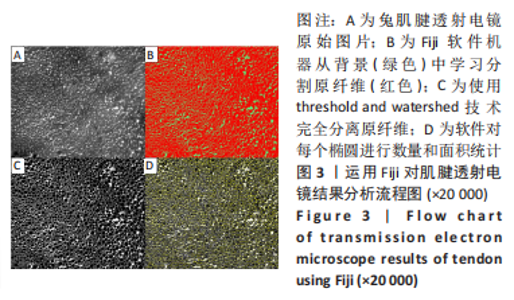
2.2 透射电镜下观察各组肌腱胶原原纤维直径及其分布 2.2.1 胶原原纤维直径 对照组、实验1组和实验2组肌腱的平均直径分别为(91.33±19.70),(136.67±3.44),(157.33±10.03) nm,3组间比较差异有显著性意义(F=40.96,P < 0.01);对照组、实验1组和实验2组肌腱纤维密度分别为(89.36±26.41),(67.11±5.09),(57.90±7.59) N/μm2,3组间比较差异有显著性意义(F=6.03,P=0.012);对照组、实验1组和实验2组肌腱的胶原原纤维指数分别为(62.77±1.50)%,(75.34±1.76)%,(80.52±0.48)%,3组间比较差异有显著性意义(F=268.29,P < 0.01);对照组、实验1组和实验2组肌腱的质量平均直径分别为(223.06±5.25),(227.35±21.85),(258.86±17.58) nm,3组间比较差异有显著性意义,见图3,表1。"
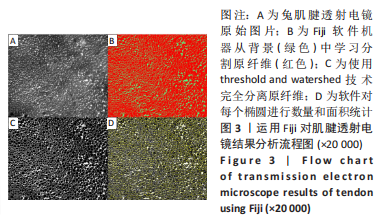
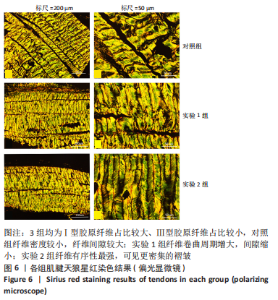
2.4 偏光显微镜下观察各组肌腱胶原类型及胶原卷曲周期 用偏振光可以清楚地观察胶原网络结构,其中Ⅰ型胶原纤维呈现厚厚的、明亮的黄色占比较大,Ⅲ型胶原纤维呈现细的绿色占比较小,3组均清晰显示胶原结构,对照组纤维密度较小,间隙比较宽松;实验1组密度有所增加,实验2组显然纤维间隙最小、密度最大,见图6。对照组、实验1组和实验2组胶原卷曲周期分别为(71.87±6.02),(37.91±3.31),(32.89±0.81) μm,3组间比较差异有显著性意义(F=141.20,P < 0.01),但事后检验实验1组和实验2组比较差异无显著性意义(P=0.07),随着交联浓度的增加,胶原卷曲周期率逐渐增大,即实验2组可见更密的褶皱,见图7。"
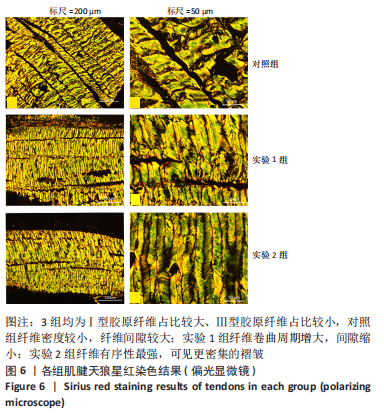
| [1] SUAREZ LS, RICHMOND JC. Overview of procurement, processing, and sterilization of soft tissue allografts for sports medicine. Sports Med Arthrosc Rev. 2007;15(3):106-113. [2] EASTLUND T. Bacterial infection transmitted by human tissue allograft transplantation. Cell Tissue Bank. 2006;7(3):147-166. [3] ZHOU M, ZHANG N, LIU X, et al. Tendon allograft sterilized by peracetic acid/ethanol combined with gamma irradiation. J Orthop Sci. 2014; 19(4):627-636. [4] FARAGO D, KOZMA B, KISS RM. Different sterilization and disinfection methods used for human tendons - a systematic review using mechanical properties to evaluate tendon allografts. BMC Musculoskelet Disord. 2021;22(1):404. [5] YANG X, FENG J, WANG F, et al. Irradiation sterilization used for allogenetic tendon: a literature review of current concept. Cell Tissue Bank. 2019;20(2):129-139. [6] XU MY, ZHANG HR, ZHANG L, et al. Peracetic Acid-Ethanol Processed Human Tendon Allograft: A Morphological, Biochemical, and Biomechanical Study In Vitro. Orthop Surg. 2021; doi:10.111/os.13030. [7] HU W, WANG Z, XIAO Y, et al. Advances in crosslinking strategies of biomedical hydrogels. Biomater Sci. 2019;7(3):843-855. [8] KEW SJ, GWYNNE JH, ENEA D, et al. Synthetic collagen fascicles for the regeneration of tendon tissue. Acta Biomater. 2012;8(10):3723-3731. [9] ENEA D, GWYNNE J, KEW S, et al. Collagen fibre implant for tendon and ligament biological augmentation. In vivo study in an ovine model. Knee Surg Sports Traumatol Arthrosc. 2013;21(8):1783-1793. [10] SHEPHERD JH, GHOSE S, KEW SJ, et al. Effect of fiber crosslinking on collagen-fiber reinforced collagen-chondroitin-6-sulfate materials for regenerating load-bearing soft tissues. J Biomed Mater Res A. 2013; 101(1):176-184. [11] ULUBAYRAM K, AKSU E, GURHAN SI, et al. Cytotoxicity evaluation of gelatin sponges prepared with different cross-linking agents. J Biomater Sci Polym Ed. 2002;13(11):1203-1219. [12] OLDE DAMINK LH, DIJKSTRA PJ, VAN LUYN MJ, et al. Cross-linking of dermal sheep collagen using a water-soluble carbodiimide. Biomaterials. 1996;17(8):765-773. [13] OLDE DAMINK LH, DIJKSTRA PJ, VAN LUYN MJ, et al. In vitro degradation of dermal sheep collagen cross-linked using a water-soluble carbodiimide. Biomaterials. 1996;17(7):679-684. [14] ZEEMAN R, DIJKSTRA PJ, VAN WACHEM PB, et al. Successive epoxy and carbodiimide cross-linking of dermal sheep collagen. Biomaterials. 1999;20(10):921-931. [15] AHN JI, KUFFOVA L, MERRETT K, et al. Crosslinked collagen hydrogels as corneal implants: effects of sterically bulky vs. non-bulky carbodiimides as crosslinkers. Acta Biomater. 2013;9(8):7796-7805. [16] CAI J, ZHANG L, CHEN J, et al. Silk fibroin coating through EDC/NHS crosslink is an effective method to promote graft remodeling of a polyethylene terephthalate artificial ligament. J Biomater Appl. 2019; 33(10):1407-1414. [17] WANG Y, WANG X, SHANG J, et al. Repairing the ruptured annular fibrosus by using type I collagen combined with citric acid, EDC and NHS: an in vivo study. Eur Spine J. 2017;26(3):884-893. [18] GOODARZI H, JADIDI K, POURMOTABED S, et al. Preparation and in vitro characterization of cross-linked collagen-gelatin hydrogel using EDC/NHS for corneal tissue engineering applications. Int J Biol Macromol. 2019;126:620-632. [19] SCHEFFEL DL, BIANCHI L, SOARES DG, et al. Transdentinal cytotoxicity of carbodiimide (EDC) and glutaraldehyde on odontoblast-like cells. Oper Dent. 2015;40(1):44-54. [20] AHMAD Z, SHEPHERD JH, SHEPHERD DV, et al. Effect of 1-ethyl-3-(3-dimethylaminopropyl) carbodiimide and N-hydroxysuccinimide concentrations on the mechanical and biological characteristics of cross-linked collagen fibres for tendon repair. Regen Biomater. 2015; 2(2):77-85. [21] YEH WL, LIN SS, YUAN LJ, et al. Effects of hyperbaric oxygen treatment on tendon graft and tendon-bone integration in bone tunnel: biochemical and histological analysis in rabbits. J Orthop Res. 2007; 25(5):636-645. [22] SCHINDELIN J, ARGANDA-CARRERAS I, FRISE E, et al. Fiji: an open-source platform for biological-image analysis. Nat Methods. 2012;9(7): 676-682. [23] SUZUKI D, OTSUBO H, WATANABE T, et al. Ultrastructure of the three anterior cruciate ligament bundles. Clin Anat. 2015; 28(7): 910-916. [24] JONES PN. On collagen fibril diameter distributions. Connect Tissue Res. 1991;26(1-2):11-21. [25] SETO A, GATT CJ, JR., DUNN MG. Improved tendon radioprotection by combined cross-linking and free radical scavenging. Clin Orthop Relat Res. 2009;467(11):2994-3001. [26] CARUSO AB, DUNN MG. Functional evaluation of collagen fiber scaffolds for ACL reconstruction: cyclic loading in proteolytic enzyme solutions. J Biomed Mater Res A. 2004;69(1):164-171. [27] HU Y, LIU L, DAN W, et al. Synergistic effect of carbodiimide and dehydrothermal crosslinking on acellular dermal matrix. Int J Biol Macromol. 2013;55:221-230. [28] POWELL HM, BOYCE ST. EDC cross-linking improves skin substitute strength and stability. Biomaterials. 2006;27(34):5821-5827. [29] LOMAS RJ, JENNINGS LM, FISHER J, et al. Effects of a peracetic acid disinfection protocol on the biocompatibility and biomechanical properties of human patellar tendon allografts. Cell Tissue Bank. 2004; 5(3):149-160. [30] HUANG YZ, WANG JJ, HUANG YC, et al. Organic composite-mediated surface coating of human acellular bone matrix with strontium. Mater Sci Eng C Mater Biol Appl. 2018;84:12-20. [31] XIAO D, ZHANG Y, WANG R, et al. Emodin alleviates cardiac fibrosis by suppressing activation of cardiac fibroblasts via upregulating metastasis associated protein 3. Acta Pharm Sin B. 2019;9(4):724-733. [32] LI N, ZHOU L, XIE W, et al. Alkaline phosphatase enzyme-induced biomineralization of chitosan scaffolds with enhanced osteogenesis for bone tissue engineering. Chemi Eng. 2019;371:618-630. [33] EDWARDS JH, HERBERT A, JONES GL, et al. The effects of irradiation on the biological and biomechanical properties of an acellular porcine superflexor tendon graft for cruciate ligament repair. J Biomed Mater Res B Appl Biomater. 2017;105(8):2477-2486. [34] BIRCH HL, THORPE CT, RUMIAN AP. Specialisation of extracellular matrix for function in tendons and ligaments. Muscles Ligaments Tendons J. 2013;3(1):12-22. [35] LEE AH, ELLIOTT DM. Comparative multi-scale hierarchical structure of the tail, plantaris, and Achilles tendons in the rat. J Anat. 2019;234(2): 252-262. [36] NICHOLLS SP, GATHERCOLE LJ, SHAH JS. Morphology of human palmaris longus tendon. Ann Rheum Dis. 1984;43(3):477-482. [37] CUI J, NING LJ, YAO X, et al. Influence of the integrity of tendinous membrane and fascicle on biomechanical characteristics of tendon-derived scaffolds. Biomed Mater. 2020;16(1):015029. [38] LI Y, WU B, QIU Z, et al. [A correlation study between the Mohawk expression level and the collagen fiber diameter of hamstring tendon graft after anterior cruciate ligament reconstruction]. Zhongguo Xiu Fu Chong Jian Wai Ke Za Zhi. 2019;33(9):1095-1101. [39] TAKAHASHI N, KAMETANI K, OTA R, et al. Three-dimensional ultrastructure reconstruction of tendinous components at the bifurcation of the bovine superficial digital flexor tendon using array and STEM tomographies. J Anat. 2021;238(1):63-72. [40] SCHMIDT EC, CHIN M, AOYAMA JT, et al. Mechanical and Microstructural Properties of Pediatric Anterior Cruciate Ligaments and Autograft Tendons Used for Reconstruction. Orthop J Sports Med. 2019;7(1):2325967118821667. |
| [1] | Xiong Bohan, Yu Yang, Lu Xiaojun, Wang Xu, Yang Tengyun, Zhang Yaozhang, Liao Xinyu, Zhou Xiaoxiang, He Lu, Li Yanlin. Research progress in promoting tendon to bone healing during anterior cruciate ligament reconstruction [J]. Chinese Journal of Tissue Engineering Research, 2023, 27(5): 779-786. |
| [2] | Wu Mingjie, Li Liang, Zhang Xiaoqiang, Luo Zhiping, Wu Jiachang, Sang Hongxun. Stability of anterior cruciate ligament reconstructed by double-loop titanium plate suspension under arthroscopy [J]. Chinese Journal of Tissue Engineering Research, 2023, 27(18): 2878-2883. |
| [3] | Wang Xu, Yang Tengyun, Xiong Bohan, Zhang Yaozhang, Lu Xiaojun, Long Dan, Zhao Daohong. Regeneration mechanism and problems of tissue engineering in rotator cuff tendon-bone healing [J]. Chinese Journal of Tissue Engineering Research, 2023, 27(18): 2928-2934. |
| [4] | Liu Xiaoyun, Deng Yuping, Li Feifei, Zhao Dongliang, Yang Yang, Huang Tao, Tan Wenchang, Wu Yaobin, Huang Wenhua, Li Yanbing. Effect of elastin degradation of patellar tendon on the quasi-static tensile mechanical properties [J]. Chinese Journal of Tissue Engineering Research, 2023, 27(18): 2831-2836. |
| [5] | Zhou Weibo, Zhang Yi, Liang Wenwei, Zhu Chunhui, Zhou Fulin. Limited-incision knotless repair for acute closed Achilles tendon ruptures [J]. Chinese Journal of Tissue Engineering Research, 2023, 27(17): 2687-2691. |
| [6] | Li Wei, Lin Meina, Lu Yongping, Sui Yu, Jiang Miao. Feasibility and advantages of mesenchymal stem cells for repairing Achilles tendon injury [J]. Chinese Journal of Tissue Engineering Research, 2023, 27(15): 2404-2411. |
| [7] | Hu Kai, Li Miao, Shao Yiran, Wang Jingjing, Chen Jinfa. Efficient removal of a decellularized reagent sodium dodecyl sulfate in allogeneic tissue [J]. Chinese Journal of Tissue Engineering Research, 2023, 27(15): 2311-2317. |
| [8] | Liu Xiuqi, Chen Fang, Zhong Hehe, Xiong Huazhang, Lyu Guoqing, Wu Shuhong, Liu Yi. Partial peroneus longus tendon reconstruction in the treatment of posterolateral complex injury of the knee joint [J]. Chinese Journal of Tissue Engineering Research, 2023, 27(13): 2093-2098. |
| [9] | Zheng Liang, Yu Wen, Yang Fan, Zhao Xiangyi. Eyelid reconstruction in situ using autologous tendon [J]. Chinese Journal of Tissue Engineering Research, 2023, 27(12): 1837-1841. |
| [10] | Niu Jingwei, Zhang Qingtao, Wang Na, Guan Shuo, Wang Ying. Correlation analysis between thyroid function-related Thrβ and Thrsp genes and mechanical properties of Achilles tendon development in rats [J]. Chinese Journal of Tissue Engineering Research, 2023, 27(11): 1653-1658. |
| [11] | Wu Bingshuang, Wang Zhi, Tang Yi, Tang Xiaoyu, Li Qi. Anterior cruciate ligament reconstruction: from enthesis to tendon-to-bone healing [J]. Chinese Journal of Tissue Engineering Research, 2022, 26(8): 1293-1298. |
| [12] | Yang Kuangyang, Wang Changbing. MRI evaluation of graft maturity and knee function after anterior cruciate ligament reconstruction with autogenous bone-patellar tendon-bone and quadriceps tendon [J]. Chinese Journal of Tissue Engineering Research, 2022, 26(6): 963-968. |
| [13] | Gao Cangjian, Yang Zhen, Liu Shuyun, Li Hao, Fu Liwei, Zhao Tianyuan, Chen Wei, Liao Zhiyao, Li Pinxue, Sui Xiang, Guo Quanyi. Electrospinning for rotator cuff repair [J]. Chinese Journal of Tissue Engineering Research, 2022, 26(4): 637-642. |
| [14] | Chen Dongsheng, Jia Qiyu, Abudusalamu·Alimujiang, Guo Jian, Feng Dongwei, Wu Tong, Ma Chuang. Tendon injury and repair of the hand: analysis of epidemiological factors in 737 cases [J]. Chinese Journal of Tissue Engineering Research, 2022, 26(35): 5676-5684. |
| [15] | Wei Hewei, Zheng Weipeng, Liu Zhijun, Zhao Guoyuan, Fang Weihua, Chen Sheng, Liao Zhihao, Wan Lei. Expression of autophagy in rotator cuff tendon stem cells induced by oxidative stress [J]. Chinese Journal of Tissue Engineering Research, 2022, 26(31): 4954-4961. |
| Viewed | ||||||
|
Full text |
|
|||||
|
Abstract |
|
|||||
